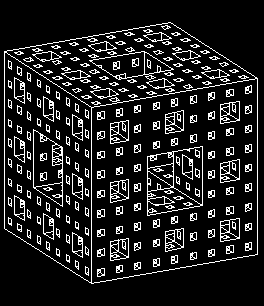
The depth 0 sponge is a single business card cube. When made from standard American business cards, it measures 2" x 2" x 2". The depth 1 sponge measuers 6" x 6" x 6", the depth 2 sponge measures 18" x 18" x 18", and the depth 3 sponge measures 54" x 54" x 54", or 4.5 feet or 1.37 meters on a side. Not outrageously large! (But it won't fit through my doorway or in my van!)
I propose to "panel" all the exposed faces. I would like to do this for several reasons. It will look better with all the flaps hidden. I would use six different colors for each of the six different planes that the faces lie in. It will be stronger, though heavier. And it lets the builders incorporate their own business cards visibly on the exterior as their "signatures". Paneling will require an extra 18,048 cards, for a total of 66,048 cards.
My largest concern is for structural integrity. 66,000 business cards are heavy. The cards that I have are of slightly higher quality than the average business card, and so are a little heavier, but also a little stronger and a little easier to fold. They weigh about 18 ounces for a box of 500. This make the projected weight of the sponge about 150 pounds (68 kg). Once built, it will not be possible to lift it off its table. I will have to build a pallet to hold it.
But if it's that heavy, can the model even support its own weight? I think it can. The bottom layer consists of 512 cubes which must support the weight of the entire structure. This would make the average load born by the bottom cubes of 8000/512 = 15.625 cubes. Further consideration reveals, however, that the middle layer is the sparsest layer in the structure, containing only 64 cubes, and must bear the weight of half the structure above it. This is a load of slightly more than 1 pound (.5 kg) per cube.
Note, however, that many of the cubes on the bottom layer have empty space above them and aren't supporting anything at all. Only 64 cubes on the bottom are connected through unbroken columns to the top of the sponge. Of course, they can still distribute load laterally to their neighboring cubes (which chiefly serve to keep them from "exploding"), but as a worst case, we can imagine that these 64 cubes carry the weight of the entire structure, with a load of around 2 pounds (1 kg) each.
So I built a cube and started stacking 1 pound weights on it. (Okay, so they were 18 ounce weights.) After the stack was 10 boxes high, the cube started to show signs of stress. And the test cube wasn't panelled.
The other potential structural problem involves shear. Think of the level 3 sponge as a ring of eight level 2 sponges on the bottom with four level 2 sponges connecting them to another ring of eight level 2 sponges on top. Four of the top sponges are supported by a column of two sponges beneath them, but the other four are supported only through their *vertical* connections to the others. Their weight might tend to cause them to crack off. Fortunately, each of these suspended sponges, weighing around 7.5 pounds (3.5 kg), are joined to their neighbors by 64 mutually connected faces on each side.
I think the structure can support itself.
By the way, a level 4 sponge would require almost a million cards and weigh over a ton. I do not believe it could support its own weight. So level 3 is the biggest sponge we can hope to build.